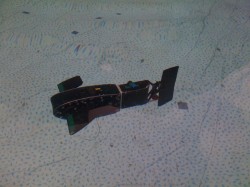 My lab hosted another successful engineering open house exhibit today at the University of Washington. I’ve been working in the Nonlinear Dynamics and Control Lab at UW for two years now and I’m close to completing my masters degree. My thesis is based on a radio transceiver that I specifically designed to enable underwater communication between our three robotic fish. Today, my transceiver was used to demo our work to the UW community and visitors to the university.
My lab hosted another successful engineering open house exhibit today at the University of Washington. I’ve been working in the Nonlinear Dynamics and Control Lab at UW for two years now and I’m close to completing my masters degree. My thesis is based on a radio transceiver that I specifically designed to enable underwater communication between our three robotic fish. Today, my transceiver was used to demo our work to the UW community and visitors to the university.
Another grad student from our lab, Dan Klein, designed the computer vision system used to track the fish in the pool. It relies on four underwater cameras calibrated to know the size of the pool and the distance between carefully measured calibration points on the walls and floor. The cameras are able to track the fish using a particle filter to probabilistically predict the fish’s location and movement. This data is then processed and converted into an x,y coordinate by the computer. My transceiver transmits the converted coordinate location from the desktop computer to the robotic fish. This way the fish knows exactly where it is in the x,y plane and a local pressure allows it to sense its depth, or position in the x,z plane.
The fish are able to swim autonomously since they know their location and depth. They will swim forward until they encounter a wall. If they encounter a wall or obstruction, they are able to turn and randomly pick a way point inside the pool to swim to. While this behavior is simplistic, it is perfect to demonstrate the capabilities of our robotic fish, computer vision system and underwater radio transceiver. We are doing much more advanced work in the lab.
Many of the visitors to the open house were kids between the ages of 10 to 17. I was astounded at some of the questions I received from them – they were quite intelligent. I was asked questions like “What is the kinetic energy of the fish?” and “What are the applications of your research?”. I even had an eleven year old girl ask me why we chose a vertically oriented tail over a horizontal one (more common to whales). This group of young visitors stands in stark contrast to last year’s crowd who asked traditional childish questions: “Can your fish jump twenty feet?”, “How fast can it go?”, and my personal favorite: “Does the fish have laser beams?”



